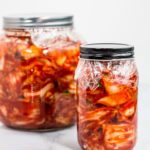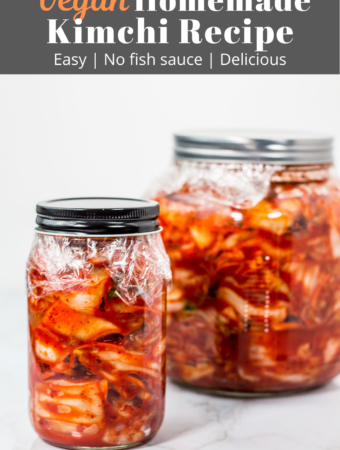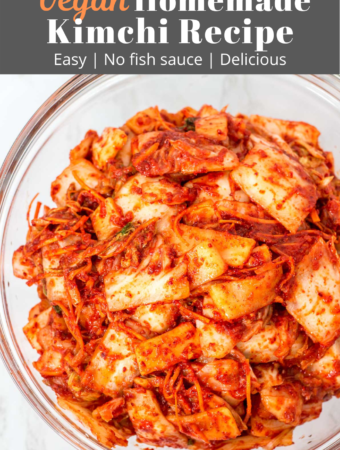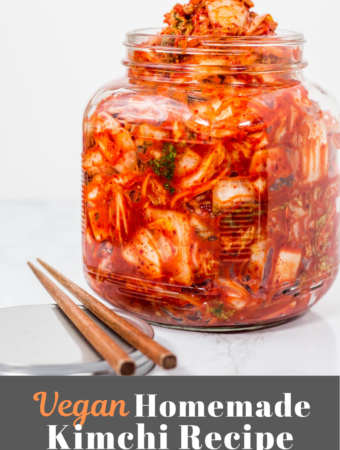Homemade Vegan Kimchi (Version 2)
Getting low on your kimchi supply? Worry not! Homemade vegan kimchi (version 2) is as delicious as my original vegan kimchi made with fewer ingredients!
- Prep Time: 4 hours
- Total Time: 4 hours
- Yield: About 5 pounds of kimchi
- Category: Side Dish
- Method: Mix
- Cuisine: Korean
- Diet: Vegan
Ingredients
-
1 large Napa cabbage, about 4 pounds
-
1/2 cup + 1-2 tablespoons Korean coarse sea salt
-
2 cups of water
-
2-3 pieces of Korean dried kelp/kombu (Da-shi-ma)
-
2 tablespoons flour
-
6-7 cloves garlic
-
1-2 tablespoons sugar
-
1/4 large onion, roughly chopped
-
1 small apple, roughly chopped
-
1 carrot, cut into match stick
-
1 small size daikon (about 1 pound), cut into small pieces
-
3/4 cup Korean red pepper flakes (gochugaru)
Instructions
-
Cut the cabbage in half, lengthwise. Cut them again lengthwise. Cut them once again lengthwise. Cut the cabbage into big bite-size ( they will shrink after the salting process). Place the cabbage in a large bowl and soak them under cold water.
-
In another large bowl, take some of the cabbage out of the water (No need to drain them well) and sprinkle about a couple of tablespoons of Korean coarse sea salt on top. Repeat the process until all the cabbages are sprinkled with salt. Pour about 1 cup of water on top. Let the cabbage salt for about 90 minutes.
-
About after 90 minutes, mix the cabbage around. It is perfectly normal to see a large amount of water collected at the bottom of the bowl. Try to place the cabbage that was soaked under the water to the top and bring cabbages they were on top to be submerged on the bottom. This ensures all the cabbage pieces to be salted evenly. Continue to salt the cabbage for additional 45-60 minutes.
-
Cut the daikon into small pieces. In a medium-size bowl and pour about 1/2 cup of the salted water that was collected on the bottom of the cabbage. Soak the daikon for 15-20 minutes. Drain the daikon and set it aside.
-
Prepare your kimchi sauce. Boil about a cup of water. Once the water comes to a boil, turn off the heat and place the dried kelp/kombu in the water. Let it steep for 10 min. Take the kelp out of the water and add 2 tablespoons of flour and whisk until you no longer see the clumps of flour. Turn on the heat to medium and let it simmer for a couple of minutes until it thickens. After a couple of minutes, turn off the heat and let this mixture comes to room temperature.
-
Either using an immersion blender or regular blender, blend the garlic cloves, onion, apple, and flour mixture until smooth. Transfer this mixture to a bowl and mix together Korean red pepper flakes, sugar, and 1-2 tablespoon of Korean coarse sea salt. Set aside.
-
Grab a piece of salted cabbage (the white stem part of the cabbage) and try to bend the piece. If the piece bends without breaking, it is ready. Rinse the cabbage under cold water a couple of times. Squeeze out the water from the cabbage and transfer them into a large bowl.
-
Gently toss together (don’t be rough with the vegetables) your daikon, cabbage, carrots, and half of the sauce until all the veggies are well coated with kimchi sauce. Taste your kimchi and adjust the sauce. If you want it to be a little spicier, add more.
-
Transfer the kimchi into a big container. You can enjoy the kimchi right away. If you want your kimchi to be sour, let your kimchi sit on the countertop for a day or two until it ferments to your liking. Keep in the fridge afterward.
Notes
- When making the sauce, you can adjust the sugar and salt amount. Don't be afraid to taste your sauce to adjust the amount.
- Don't be rough mixing the sauce and the vegetables. Gently toss them together until all the veggies are coated with the sauce. This helps your kimchi stay crisp longer.
- When transferring your kimchi to a container, do NOT overfill. Leave about 3 inches of room on top of kimchi. I overfilled the kimchi for picture taking purposes only. I transferred my kimchi into a second container afterward. When kimchi ferments, it produces water. If you overfill your kimchi, the water produced by the cabbage and other vegetables WILL leak out and make a stinky mess.
Find it online: https://www.myeclecticbites.com/homemade-vegan-kimchi-version-2/



